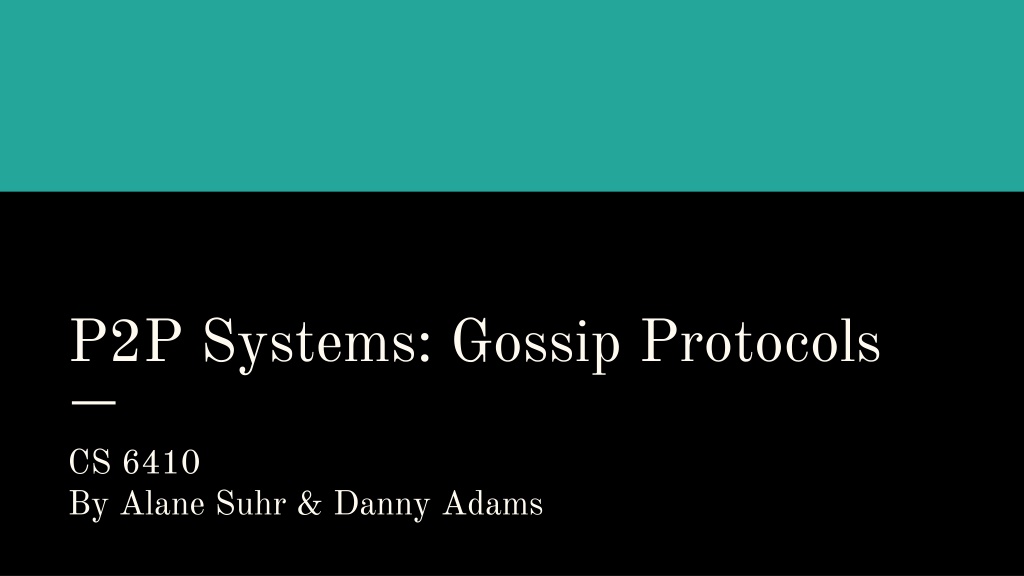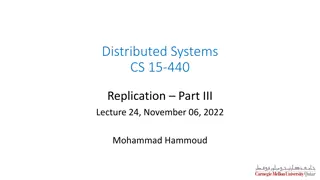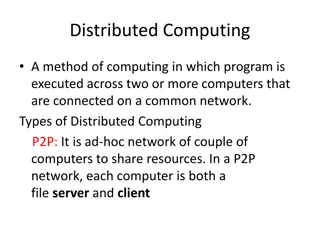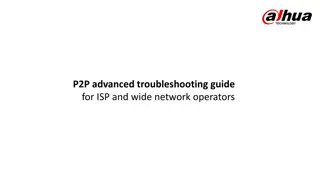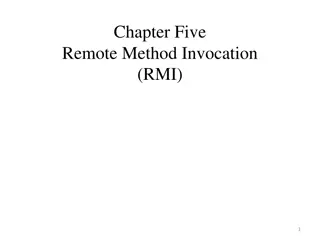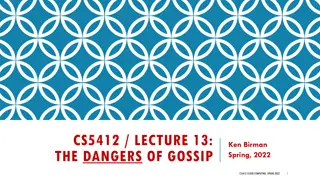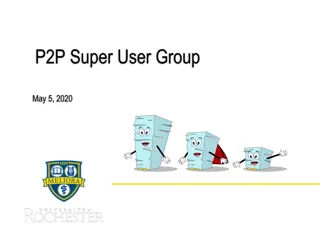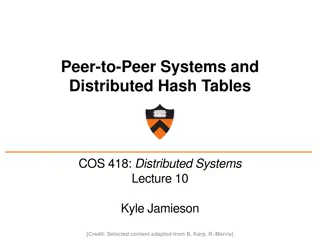Understanding P2P Systems and Gossip Protocols in Distributed Computing
Delve into the world of P2P systems and gossip protocols through a comprehensive exploration of CAP Theorem, epidemic algorithms, managing update conflicts, and key events in distributed systems history. Learn about the prioritization of consistency versus availability, the roles of Paxos and Gossip protocols, and the motivations driving research in this field.
Download Presentation

Please find below an Image/Link to download the presentation.
The content on the website is provided AS IS for your information and personal use only. It may not be sold, licensed, or shared on other websites without obtaining consent from the author. Download presentation by click this link. If you encounter any issues during the download, it is possible that the publisher has removed the file from their server.
E N D
Presentation Transcript
P2P Systems: Gossip Protocols CS 6410 By Alane Suhr & Danny Adams 1
Outline Timeline CAP Theorem Epidemic algorithms for replicated database maintenance Managing update conflicts in Bayou, a weakly connected replicated storage system Conclusion 2 A
Timeline 1978 1982 1985 1987 1990 1995 1998 Lamport Lamport FLP Demers Schneider Terry Lamport Implementing fault-tolerant services using the state machine approach: A tutorial The part-time parliament Time, Clocks, and the Ordering of Events in a Distributed System The Byzantine Generals Problem Impossibility of Distributed Consensus with One Faulty Process Epidemic algorithms for replicated database maintenance Managing update conflicts in Bayou, a weakly connected replicated storage system 3 A
CAP Consistency -- all nodes contain the same state Availability -- requests are responded to promptly Partition part of a system completely independent from the rest of the system ideally should maintain itself autonomously Partition tolerance -- system can stay online and functional even when message passing fails 4 A
CAP Theorem Paxos: prioritize consistency given a network partition Gossip: prioritize availability given a network partition Paxos & Gossip 5 A
Gossip 6 6 D
Gossip Overview Authors Motivations Epidemic Models Direct Mail Anti-Entropy Rumor mongering Evaluation DC s Spatial Distribution 7 D
A u t h o r s Carl Hauser PhD Cornell Washington State University Alan Demers Cornell University Dan Greene PARC Research Scott Shenker EECS Berkeley Doug Terry Amazon Web Services 8 D
Motivations Unreliable network Unreliable nodes CAP: *AP* always be able to respond to a (read/write) request eventual consistency 9 D
Epidemic Models 10 A
Proposers and Acceptors Proposer In Paxos: clients propose an update to the database Epidemic model: a node infects its neighbors Acceptor In Paxos: acceptor accepts an update based on one or more proposals Epidemic model: a node is infected by a neighbor 11 A
Types of Epidemics Direct Mail Anti-Entropy Rumor Mongering A 12
Advantages Simple algorithms High Availability Fault Tolerant Tunable Scalable Works in Partition 13 A
Notify all neighbors of an update Timely and reasonably efficient n messages per update Direct Mail 14 D
Direct Mail 15 D
Direct Mail 16 D
Direct Mail Messages sent: O(n) where n is number of neighbors Not fault tolerant -- doesn t guarantee eventual consistency High volume of traffic with site at the epicenter 17 D
Anti-Entropy Site chooses random partner to share data Number of rounds til consistency: O(log n) Sites use custom protocols to resolve conflicts Fault tolerant 18 A
Anti-Entropy 19 A
Anti-Entropy 20 A
Anti-Entropy 21 A
Anti-Entropy 22 A
Anti-Entropy 23 A
Anti-Entropy 24 A
Anti-Entropy 25 A
Anti-Entropy 26 A
Anti-Entropy What happens next? 27 A
Push vs. Pull Push Pull {A, B} {A, C} {A, B} {A, C} H(A), H(B) H(A), H(B) H(B C B {A, B} {A,B,C} {A, B, C} {A, C} 29 D
{A, B} {A, C} What is Push-Pull? H(A), H(B) C, H(B) B 30 {A, B, C} {A,B,C} D
Propagation times of Push vs. Pull Push: Pi+1 = Pie-1 Pull: Pi+1= Pi2 Pull is faster!! P= Probability node hasn t received update after the ithround 31 D
Rumor Mongering Sites choose a random neighbor to share information with Transmission rate is tuneable 1. How long new updates are interesting is also tuneable 2. Can use push or pull mechanisms 32 A
Rumor Mongering Complexity O(ln n) rounds leads to consistency with high probability Push requires O(n ln n) transmissions until consistency Further proved lower bound for all push- pull transmissions: 0(n ln ln n) 33 Karp et al 2000. Randomized rumor spreading. In FOCS. A
Analogy to epidemiology Susceptible: site does not know an update yet Infective: actively sharing an update Removed: updated and no longer sharing Rumor mongering: nodes go from susceptible to infective and eventually (probabilistically) to removed 34 A
Rumor mongering 35 A
Rumor mongering 36 A
Rumor mongering 37 A
Rumor mongering 38 A
Rumor mongering 39 A
Rumor mongering 40 A
Rumor mongering A 41 A
Rumor mongering Pros: Cons: Fast Low call on resources Fault-Tolerant Less traffic A site can potentially miss an update 42 A
Backups Anti-entropy can be used to update the network regularly after direct mail or rumor mongering If inconsistency found in anti- entropy, run the original algorithm again 43 D
Death Certificates How are items deleted using epidemic models? 44 D
I DONT like Bread! I like Bread System Update I like orange juice 45 D
Death Certificates How to remove items from epidemic model? Drawbacks Space Increases traffic DC Can be lost 46 Dormant death D
Evaluating Epidemic Models Residue: remaining susceptibles when epidemic finishes Traffic: Delay: Tavg: Average time between start of outbreak and arrival of update @ given site Tlast: Delay until last update 47 D
Spatial Distribution Helping Or Hurting 48 A
Convergence Times and Traffic Linear network: anti entropy Nearest-neighbors O(n) convergence O(1) traffic Random connections O(log(n)) convergence O(n) traffic 49 A
Optimizations for realistic network distributions Select connections from list of neighbors sorted by distance Treat network as linear Compute probabilities based on position in list 50 A
